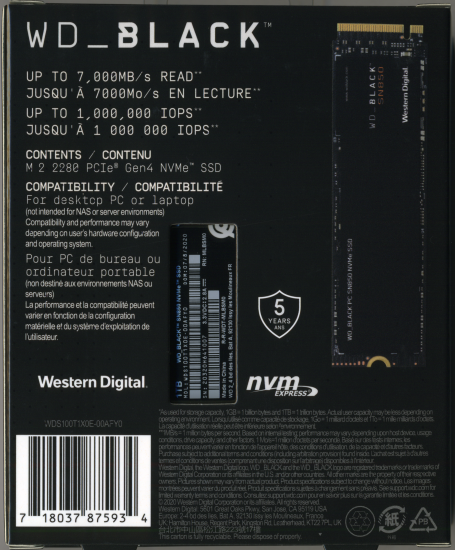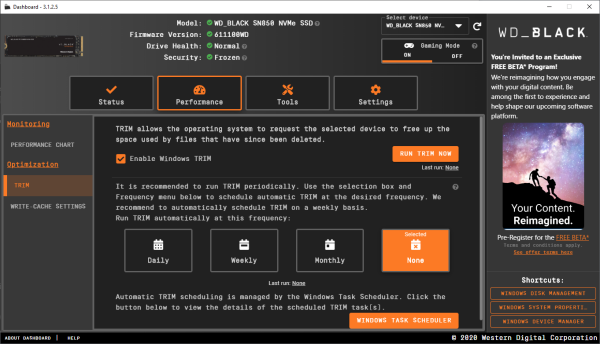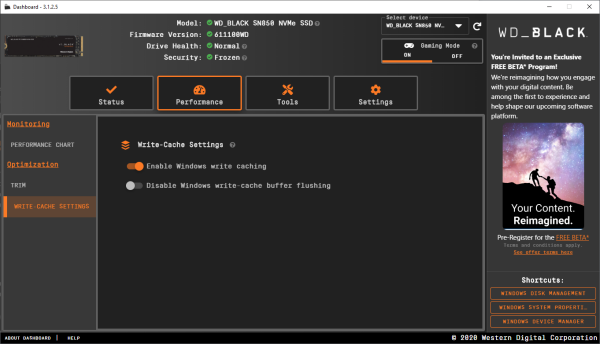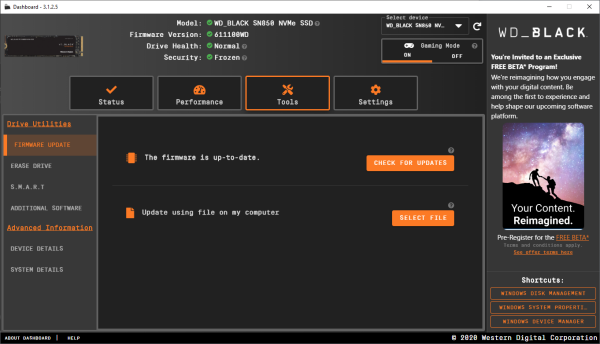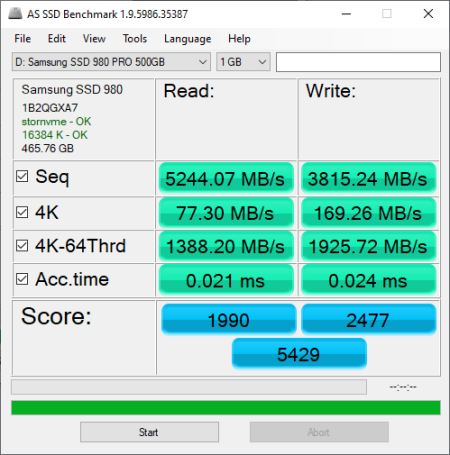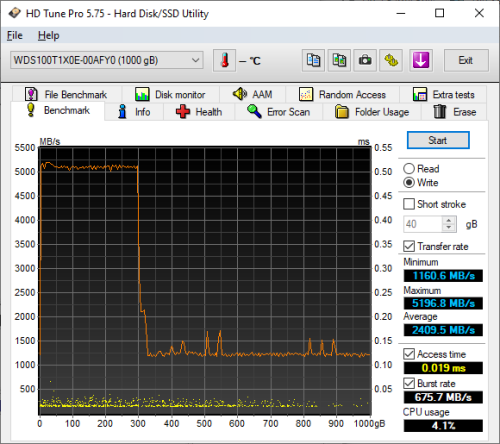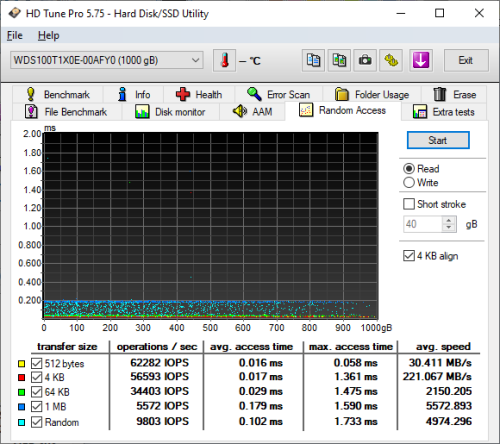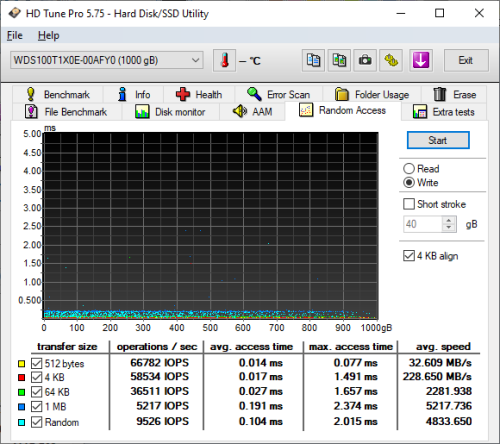

Model: Western Digital WD_BLACK SN850 1TB NVMe PCIe 4.0 Solid State Drive
Manufacturer: Western Digital
Provided By: Western Digital
As one of the biggest names in the storage industry, Western Digital doesn't need much of an introduction. Founded in 1970, the company got its start by manufacturing calculator chips. As time went on, Western Digital expanded into the PC market, adding floppy and hard disc controllers to its product lineup. It wasn't until 1988 that it introduced its "Centaur" series of hard drives. Since then, the company has grown to become the world's second largest manufacturer of hard drives. Western Digital currently offers a wide range of internal and external hard drives as well as a growing number of multimedia devices, SSDs and network storage solutions.
Western Digital recently introduced three new WD_BLACK NVMe SSDs. In addition to the AN1500 add-in-card and the D50 game dock, the company released its first NVMe SSD with next-gen PCIe Gen4 technology, the WD_BLACK SN850. Optimized for top-tier and high-intensive gaming, this single-sided M.2 form factor drive is powered by Western Digital's new G2 controller and is available with up to 2TB of the company's 96-layer BiCS 3D TLC NAND flash. The WD_BLACK SN850 is also available with or without an RGB-enabled heatsink and is equipped with an ultra-fast PCIe Gen4 x4 interface to deliver up to 7,000 MB/s read and 5,300 MB/s write speeds. Last, but not least, users can customize and control their gaming experience with the downloadable WD_BLACK Dashboard software.
The WD_BLACK SN850 is available in 500GB, 1TB and 2TB capacities. For this review, Western Digital sent us the heatsink-less 1TB version of the drive, which is capable of delivering up to 7,000 MB/s sequential read and 5,300 MB/s sequential write speeds as well as up to 1,000,000 IOPS.

Needless to say, this is only a taste of what the WD_BLACK SN850 has to offer. To give you an idea of what to expect, we'll take a closer look at Western Digital's new PCIe 4.0 SSD and then see how well it performs. Does the WD_BLACK SN850 have what it takes? Can it deliver the performance and features that we've come to expect from Western Digital? Keep reading as we find out.
The WD_BLACK SN850 comes in a small, black box. Along with a picture of the drive, the front advertises a few of its key features including its 1TB capacity, Gen4 interface and maximum read speed. The back of the box also has a small window that lets you see the drive and view the model name and serial number.
Physical Features:
The WD_BLACK SN850 uses the 2280 form factor for M.2 (NGFF) SSDs. It measures 22 x 80 x 2.38 mm and tips the scales at a mere 7.5g. The drive also has an "M key" edge connector which provides PCIe SSDs with up to 4x lanes of bandwidth.
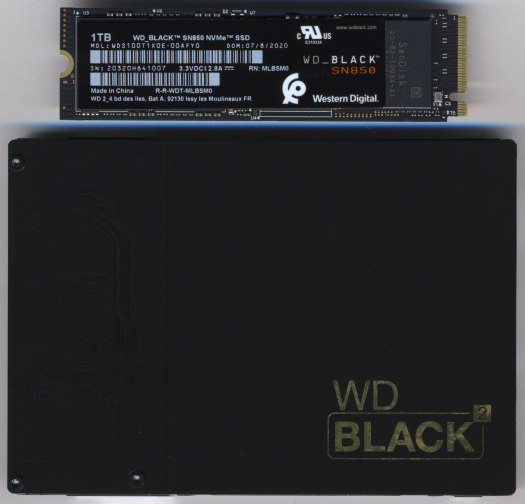
The WD_BLACK SN850 uses Western Digital's new G2 (20-82-10034-A1) controller. Not much is known about this controller aside from that it delivers improved low queue-depth performance over its predecessor as well as faster file transfers thanks in part to a new cache technology.


For the 1TB version of the WD_BLACK SN850, Western Digital has opted to use its own 96-layer 3D TLC NAND flash. Looking at the picture above, you can see that there are two 512GB NAND flash packages on the top of the PCB. The drive also has a single 1GB DDR4 SDRAM memory chip that is used for caching.
Like Western Digital's other SSDs, the WD_BLACK SN850 works with their WD_BLACK Dashboard software. This easy to use, Windows-based utility gives users the ability to manage and monitor their drives. From the main screen, you can check the status of your SSD and view information like the firmware version, capacity, temperature, interface speed and the life remaining.
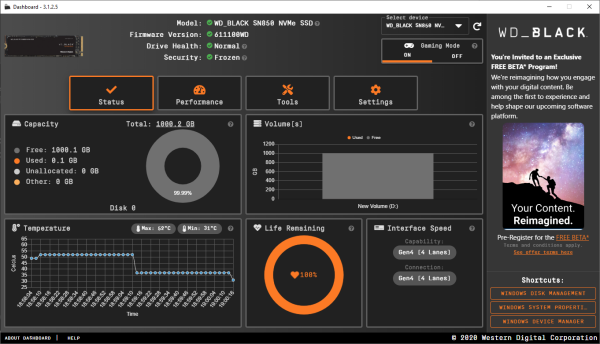
With the WD_BLACK SN850, you can also enable what Western Digital calls "Gaming Mode." This feature disables the low power mode function on the SSD which keeps it running at peak levels.
The SSD Dashboard also gives users the ability to monitor the performance of their drives. The chart provides two different real time performance metrics: transfer speed MB/s (megabytes per second) and transfer IOPS (I/O operation count per second).
The Tools section offers a number of options, including the ability to do a firmware update and perform a secure erase. The SSD Dashboard also has the ability to run S.M.A.R.T. diagnostic tests and provide details about your drives and system.
From within the Settings tab, you can update SSD Dashboard and configure the software so that it starts up with Windows. You can also turn off write-cache buffer flushing and select from one of 17 languages.
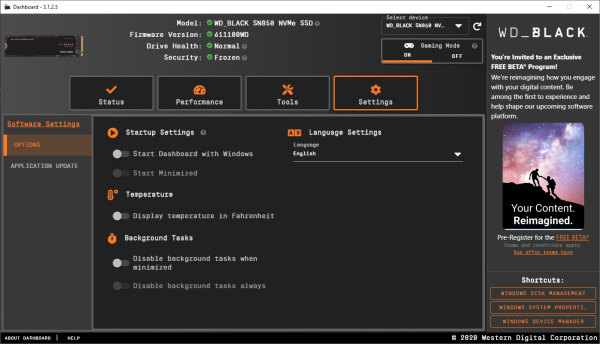
Last, but not least, you have the Help section which contains links to Western Digital's support page as well as their end user forums.

The test system used in this review is equipped with an AMD Ryzen 3 3100 CPU, MSI B550 GAMING PLUS motherboard, 16GB (8GB x 2) of Crucial Ballistix 3200 MHz DDR4 memory, Crucial P5 1TB SSD and a GIGABYTE GeForce GTX 1060 WINDFORCE OC 6G graphics card. For the operating system, I used the latest version of Windows 10 Pro.
To test the performance of Western Digital's WD_BLACK SN850 SSD, I ran a series of benchmarks using CrystalDiskMark, HD Tach RW, ATTO Disk Benchmark, AS SSD, HD Tune Pro, Anvil's Storage Utilities, Iometer and PCMark. For comparison, I've also included test results from the Silicon Power US70, ADATA XPG GAMMIX S50 Lite, Silicon-Power UD70, Crucial P2, Samsung's 980 PRO, SK hynix Gold P31, Crucial P5, ADATA SWORDFISH, ADATA FALCON, Lexar NM610, Silicon Power P34A60, Patriot P300, Plextor M9PG Plus, Plextor M9PY Plus, ADATA XPG SX6000 Pro, Western Digital WD_BLACK SN750, Samsung 970 EVO Plus, ADATA XPG SX8200 Pro, Crucial P1, ADATA XPG SX8200, Western Digital WD_BLACK NVMe, Samsung 970 EVO, Samsung 970 PRO, Plextor M9Pe, Plextor M8Se, Patriot Hellfire, ADATA XPG SX8000, Samsung 960 PRO, Toshiba OCZ RD400, Samsung 950 PRO, Samsung 870 QVO, Silicon Power P60, SK hynix Gold S31, ADATA Ultimate SU750, Samsung 860 QVO, Samsung 860 PRO and Crucial MX500.

As I mentioned earlier, the WD_BLACK SN870 uses Western Digital's new G2 controller chip. Looking at the screenshot above, you can see that it performs equally well with both incompressible (0%) and compressible (100%) data.
CrystalDiskMark 7.0.0:
First, I ran a few quick tests using CrystalDiskMark. This benchmark measures the performance of a storage device by testing its sequential and random read and write speeds. For this test, we're using the peak and real world profiles.
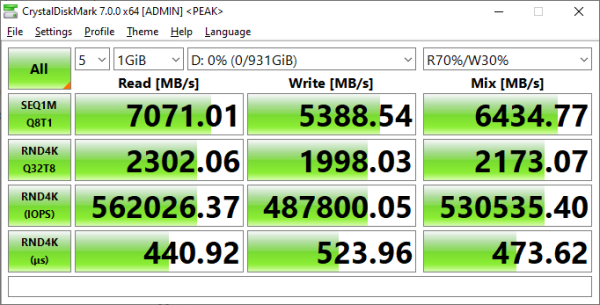
According to Western Digital, the 1TB WD_BLACK SN850 is capable of reading at 7,000 MB/s and writing at 5,300 MB/s. Looking at the screenshot above, you can see that the drive had no problems reaching these speeds in CrystalDiskMark's sequential read and write tests.
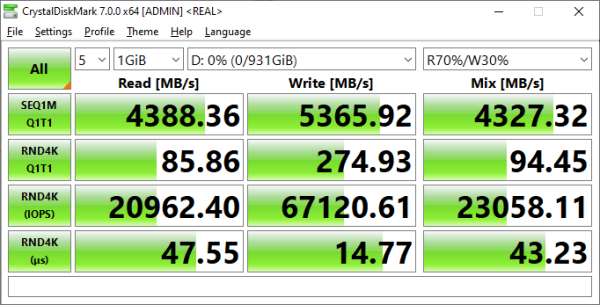
As you'd expect, the WD_BLACK SN850 wasn't as fast when tested with the "real world" profile which uses a single thread and a much lower queue depth. Nevertheless, it was still able to read at 4,388 MB/s and write at more than 5,300 MB/s.
HD Tach RW 3.0.4.0:
Next, I used HD Tach to test the WD_BLACK SN850's read, write and burst speeds as well as its random access time and CPU usage.
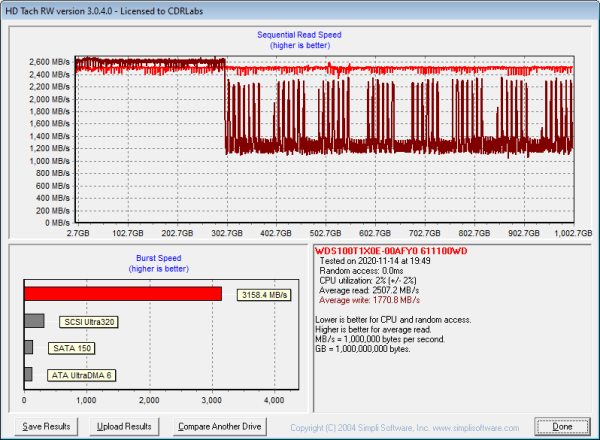
Looking at the screenshot above, you can see that the WD_BLACK SN850 had average read and write speeds of 2507.2 MB/s and 1770.8 MB/s respectively, as well as a burst speed of 3158.4 MB/s. The screenshot also shows that it uses some sort of SLC caching. The drive starts writing at about 2,600 MB/s and then drops to about 1,200 MB/s when the write operation exceeds the size of the cache.
ATTO Disk Benchmark 4.01:
I also used ATTO Disk Benchmark to test the WD_BLACK SN850's sequential read and write speeds. The tests are run using blocks ranging in size from 512B to 64 MB and the total length set to 256MB.
When tested with ATTO, the WD_BLACK SN850's read speeds topped out at about 6.59 GB/s and its write speeds at 5.02 GB/s.
AS SSD:
AS SSD is a relatively new benchmark designed specifically for solid state drives. The application contains five synthetic tests used to determine the sequential and random read and write performance of a drive.
AS SSD also includes a copy benchmark. This test copies an ISO (two large files), program (many small files) and game (small and large files), returning the speed and duration of each.
HD Tune Pro 5.75:
Next, I ran a series of tests using HD Tune Pro. This hard disk utility measures a drive's performance by testing its sequential read and write speeds as well as its access time, burst rate and CPU usage. For this review, I'm also going to use it to benchmark the WD_BLACK SN850's random read and write speeds, random access times and the number of operations per second.
The WD_BLACK SN850 performed relatively well when benchmarked with HD Tune. The drive had average read and write speeds of 5,562.3 MB/s and 2,409.5 MB/s, respectively.
When reading 4KB blocks, the WD_BLACK SN850 reached 56,593 IOPS and had an average speed of 221.067 MB/s. The drive was even faster when writing, reaching 58,534 IOPS with an average speed of 228.650 MB/s.
Anvil's Storage Utilities:
Anvil's Storage Utilities is another benchmark designed with SSDs in mind. The standard storage benchmark measures a drive's performance by testing its transfer speeds, access times and IOPS.

Iometer:
Lastly, I ran a series of tests using Iometer. This tool can be configured to benchmark a number of things. In this case, I used it to measure the WD_BLACK SN850's read and write speeds and the number of operations per second. The tests were run using random bytes and a queue depth of 3.

The WD_BLACK SN850's performance was very similar to what we saw in our other tests. The drive was able to read at 6745.62 MB/s and write at 5115.23 MB/s.

The WD_BLACK SN850 also performed very well when doing random reads and writes. In our tests, the drive was able to read at 395.34 MB/s and write at a blazing 824.23 MB/s.

According to Western Digital, the 1TB WD_BLACK SN850 is capable of 1,000,000 (yes, a million) IOPS when reading and 720,000 IOPS when writing 4K blocks. With two threads and a queue depth of three, the drive reached 101,206 random read IOPS and 211,003 random write IOPS.

As with most drives, the WD_BLACK SN850 performed better with more threads and at higher queue depths. With eight threads and the queue depth set to 32, it reached 553,222 random read IOPS and 473,092 random write IOPS. Sadly, I could not push the WD_BLACK SN850 any harder as the number of threads I could run within Iometer was limited by the processor in our test system. Needless to say, if you want to hit that magic 1,000,000 number, you'll probably want to pair the WD_BLACK SN850 with a processor that has 16 or more threads, like the Ryzen 7.
PCMark 8 - Storage Test:
PCMark 8 is a complete benchmark for Windows. It includes five benchmark tests, each designed around a specific scenario. The storage benchmark measures drive performance using real-world traces recorded from Adobe Creative Suite, Microsoft Office and a selection of popular games.

PCMark 8 also includes a consistency test which measures the performance consistency and degradation tendency of a storage system. The test reports the performance level at the start, the degraded steady-state and the recovered state as well as the number of iterations required to reach the degraded state and the recovered state. For this test, we are focusing on the Adobe Photoshop (Heavy) trace and will look at both the bandwidth and latency of the drive

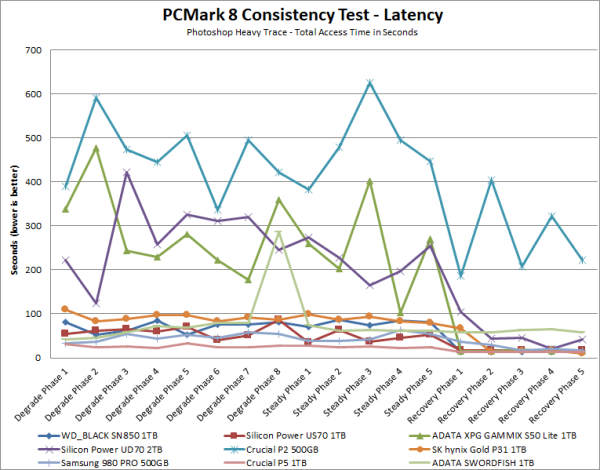
The WD_BLACK SN850's performance was hit and miss in this test. The drive was relatively quick during the degradation and steady phases. However, it lagged behind the SK hynix Gold P31 and Crucial P5 during the recovery phase, topping out at only 1,079 MB/s.
PCMark 10 - Full System Drive Benchmark:
PCMark 10's Full System Drive Benchmark uses a wide-ranging set of real-world traces from popular applications and common tasks to fully test the performance of the fastest modern drives. This benchmark produces an overall score as a measure of drive performance. Comparing devices is as simple as comparing scores. The tests also measure and report the bandwidth and average access time performance for the drive.
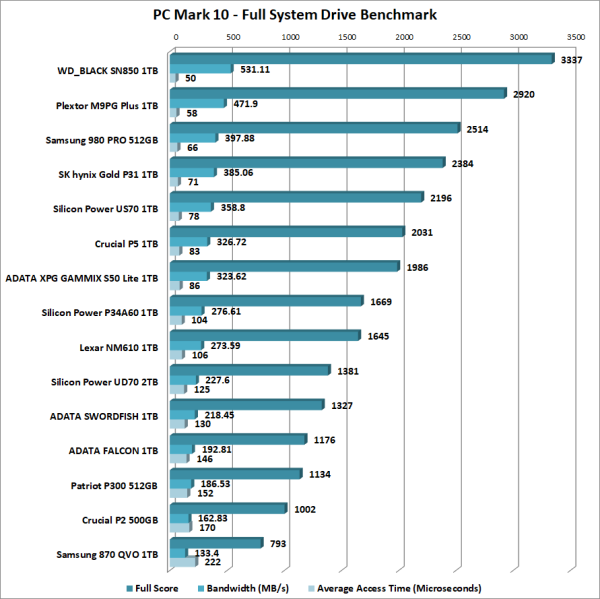
Thanks to its high bandwidth and low latency, the WD_BLACK SN850 did very well in PCMark 10's Full System Drive Benchmark. It beat both the Plextor M9PG Plus and the Samsung 980 PRO to take the top spot in this test.
TRIM Performance:
While SSD's offer many benefits, there are some downsides to using flash memory. One of the biggest issues people run into is performance degradation. Over time, an SSD will run out of fresh blocks and will have to write over data the file system has marked as deleted. This procedure is very complicated and can slow an SSD's write speeds considerably.
To fix this problem, most manufacturers have added TRIM support to their SSDs. The TRIM command allows an operating system, such as Windows 10, to tell an SSD which data blocks are no longer in use. Using this information, the drive pro-actively erases these blocks and adds them to the free block pool.

To test the WD_BLACK SN850's TRIM and garbage collection functions, I first put the drive in a "dirty" state. I used Iometer to fill 80% of the drive and then ran a random write test for 30 minutes. Looking at the screenshot below, you can see that the WD_BLACK SN850's average read and write speeds dropped to 4760.27 MB/s and 477.08 MB/s, respectively.

WD_BLACK SN850 - Dirty
To see how well the WD_BLACK SN850 could recover, I let the computer sit for about 30 minutes and then reran the test. The drive wasn't able to reach the factory fresh performance shown in our earlier tests. However, its sequential write speed climbed up to 743.12 MB/s.

WD_BLACK SN850 - After TRIM
Lastly, I used Parted Magic to perform a secure erase on the WD_BLACK SN850. With the drive wiped clean, it had average read and write speeds of 5632.23 MB/s and 4984.57 MB/s, respectively.

WD_BLACK SN850- Secure Erased
Final Thoughts:
Western Digital has clearly put a lot of time and effort into their new WD_BLACK SN850 SSD. In an effort to deliver the full potential of next-gen PCIe Gen4 technology, everything, from the WD_BLACK G2 controller to the 96-layer BiCS 3D TLC NAND flash, has been developed in house. Needless to say, this effort has paid off in spades as the WD_BLACK SN850 is one of the fastest consumer SSDs currently available. The 1TB version of the drive screamed through our sequential transfer rate tests, reading at speeds as high as 7,071 MB/s and writing at more 5,300 MB/s. It also did very well in our random write tests, producing nearly 211,000 IOPS at low queue depths.
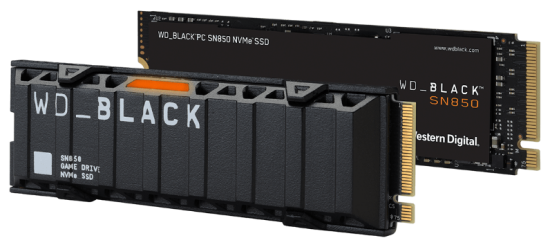
The WD_BLACK SN850 is available now without the heatsink in 500GB, 1TB and 2TB capacities. Prices on Amazon.com currently range from $150 up to $450, with the 1TB version reviewed here retailing for about $230. The heatsink equipped models are expected to be available in early 2021 and will cost about $20 more.

Highs:
- Available in 500GB, 1TB and 2TB capacities
- PCIe 4.0 x4 interface with NVMe protocol
- Equipped with 96-layer BiCS3 3D TLC NAND
- Excellent sequential and random read and write speeds
- Small M.2 2280 form factor
- Large DRAM cache
- Available with or without RGB-enabled heatsink
- WD_Black Dashboard software with "gaming mode"
- 5 year warranty
Lows:
- Write speed drops considerably when SLC cache is full
- Can run hot under heavy workloads
- Does not support hardware based encryption
- Pricey

